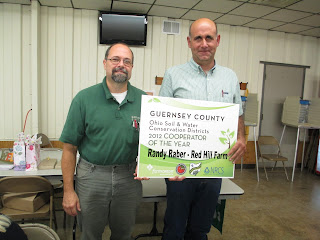On Tuesday,
October 23rd the district held
its 70th annual meeting banquet and election. Bill Bertram was re-elected to the board, and
Myron Dellinger was elected for his first term.
The two men will serve a three-year term beginning January 2012 on our board which provides direction, oversight, and fiscal accountability to the staff.
During
the annual meeting, the Conservationist of the Year award was presented to Randy
Raber of Red Hill Farm. Randy is always
conservation minded, working with the district to install extensive amounts of
fence, pipelines, and watering facilities in order to rotationally graze
pastures. He does crop rotation and is
moving toward utilizing cover crops to protect and improve soils. Randy has also helped the district in
educational programs, and has made one of his farms available for the district’s
elected officials tour, which helped showcase the district’s accomplishments in
the county.
Guest
Speaker for the evening was Dave Adair of the Guernsey Scenic Railway. Dave regaled the crowd with stories of coal
mining in the early 1900s right here in Guernsey county. They listened in rapt attention as he
described the working conditions in the mines, and how men toiled in the
dangerous, dark, and damp conditions to remove coal from the seam deep in the
earth and bring it to the surface to be used to heat homes and provide power
for electricity.
The
Guernsey Soil and Water Conservation District is a political sub-division of
the State of Ohio
Over
the years conservation districts have evolved to include issues around land
use, water quality, forestry and wildlife.
They work with landowners, land users, other governmental agencies, and
elected officials to solve natural resource concerns.


No comments:
Post a Comment